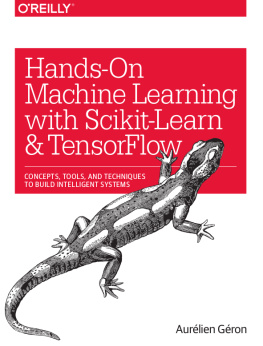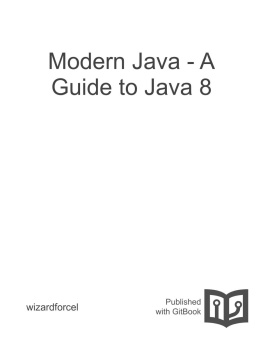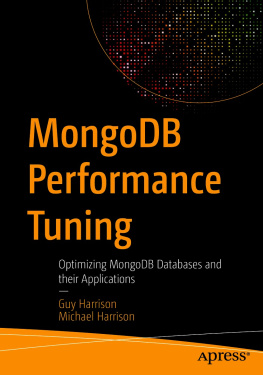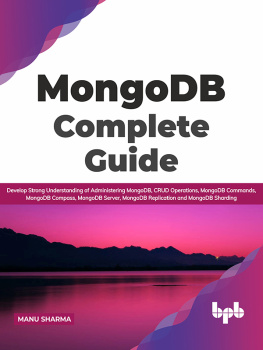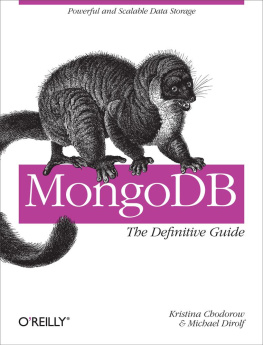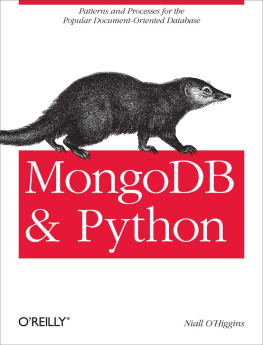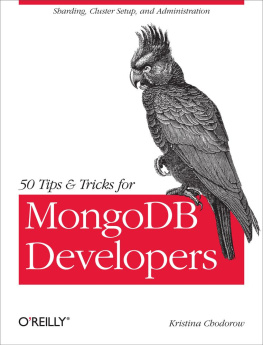it-ebooks - mongodb manual
Here you can read online it-ebooks - mongodb manual full text of the book (entire story) in english for free. Download pdf and epub, get meaning, cover and reviews about this ebook. year: 2016, publisher: iBooker it-ebooks, genre: Home and family. Description of the work, (preface) as well as reviews are available. Best literature library LitArk.com created for fans of good reading and offers a wide selection of genres:
Romance novel
Science fiction
Adventure
Detective
Science
History
Home and family
Prose
Art
Politics
Computer
Non-fiction
Religion
Business
Children
Humor
Choose a favorite category and find really read worthwhile books. Enjoy immersion in the world of imagination, feel the emotions of the characters or learn something new for yourself, make an fascinating discovery.

- Book:mongodb manual
- Author:
- Publisher:iBooker it-ebooks
- Genre:
- Year:2016
- Rating:3 / 5
- Favourites:Add to favourites
- Your mark:
- 60
- 1
- 2
- 3
- 4
- 5
mongodb manual: summary, description and annotation
We offer to read an annotation, description, summary or preface (depends on what the author of the book "mongodb manual" wrote himself). If you haven't found the necessary information about the book — write in the comments, we will try to find it.
mongodb manual — read online for free the complete book (whole text) full work
Below is the text of the book, divided by pages. System saving the place of the last page read, allows you to conveniently read the book "mongodb manual" online for free, without having to search again every time where you left off. Put a bookmark, and you can go to the page where you finished reading at any time.
Font size:
Interval:
Bookmark:
On this page
The MongoDB Manual [http://docs.mongodb.org/manual/#] containscomprehensive documentation on MongoDB. This page describes themanuals licensing, editions, and versions, and describes how to make achange request and how to contribute to the manual.
This work is licensed under a Creative CommonsAttribution-NonCommercial-ShareAlike 3.0 United States License [http://creativecommons.org/licenses/by-nc-sa/3.0/us/]
MongoDB, Inc. 2008-2016
In addition to the MongoDB Manual [http://docs.mongodb.org/manual/#] , you canalso access this content in the following editions:
- PDF Format [http://docs.mongodb.org/master/MongoDB-manual.pdf] (without reference).
- HTML tar.gz [http://docs.mongodb.org/master/manual.tar.gz]
- ePub Format [http://docs.mongodb.org/master/MongoDB-manual.epub]
You also can access PDF files that contain subsets of the MongoDB Manual:
- MongoDB Reference Manual [http://docs.mongodb.org/master/MongoDB-reference-manual.pdf]
- MongoDB CRUD Operations [http://docs.mongodb.org/master/MongoDB-crud-guide.pdf]
- Data Models for MongoDB [http://docs.mongodb.org/master/MongoDB-data-models-guide.pdf]
- MongoDB Data Aggregation [http://docs.mongodb.org/master/MongoDB-aggregation-guide.pdf]
- Replication and MongoDB [http://docs.mongodb.org/master/MongoDB-replication-guide.pdf]
- Sharding and MongoDB [http://docs.mongodb.org/master/MongoDB-sharding-guide.pdf]
- MongoDB Administration [http://docs.mongodb.org/master/MongoDB-administration-guide.pdf]
- MongoDB Security [http://docs.mongodb.org/master/MongoDB-security-guide.pdf]
MongoDB Reference documentation is also available as part of dash [http://kapeli.com/dash] . You can also access the MongoDBMan Pages [http://docs.mongodb.org/master/manpages.tar.gz] which are also distributed with theofficial MongoDB Packages.
This version of the manual reflects version 3.2 of MongoDB.
See the MongoDB Documentation Project Page [http://docs.mongodb.org] for an overview of all editions and output formats of the MongoDBManual. You can see the full revision history and track ongoingimprovements and additions for all versions of the manual from its GitHubrepository [https://github.com/mongodb/docs] .
This edition reflects master branch of the documentationas of the fa02d9ebbfd45ce04869734246e2ba9610aba243 revision. This branch is explicitly accessiblevia https://docs.mongodb.org/master and you can always reference the commit of thecurrent manual in the release.txt [http://docs.mongodb.org/master/release.txt] file.
The most up-to-date, current, and stable version of the manual isalways available at http://docs.mongodb.org/manual/.
To report an issue with this manual or to make a change request, filea ticket at theMongoDB DOCS Project on Jira [https://jira.mongodb.org/browse/DOCS] .
The entire documentation source for this manual is available in themongodb/docs repository [https://github.com/mongodb/docs] ,which is one of theMongoDB project repositories on GitHub [http://github.com/mongodb] .
To contribute to the documentation, you can open aGitHub account [https://github.com/] , fork themongodb/docs repository [https://github.com/mongodb/docs] ,make a change, and issue a pull request.
In order for the documentation team to accept your change, you mustcomplete theMongoDB Contributor Agreement [http://www.mongodb.com/contributor] .
You can clone the repository by issuing the following command at yoursystem shell:
The MongoDB Manual uses Sphinx [http://sphinx-doc.org//] , asophisticated documentation engine built upon Python Docutils [http://docutils.sourceforge.net/] . The original reStructured Text [http://docutils.sourceforge.net/rst.html] files, as well as allnecessary Sphinx extensions and build tools, are available in the samerepository as the documentation.
For more information on the MongoDB documentation process, see:
If you have any questions, please feel free to open a Jira Case [https://jira.mongodb.org/browse/DOCS] .
The administration documentation addresses the ongoing operation andmaintenance of MongoDB instances and deployments. This documentationincludes both high level overviews of these concerns as well astutorials that cover specific procedures and processes for operatingMongoDB.
Core conceptual documentation of operational practices formanaging MongoDB deployments and systems.
Describes approaches and considerations for backing up aMongoDB database.An overview of monitoring tools, diagnostic strategies, andapproaches to monitoring replica sets and sharded clusters.A collection of notes that describe best practices andconsiderations for the operations of MongoDB instances anddeployments.Continue reading from for additionaldocumentation of MongoDB administration.
Tutorials that describe common administrative procedures andpractices for operations for MongoDB instances and deployments.
Describes routine management operations, includingconfiguration and performance analysis.Outlines procedures for data backup and restoration with instances and deployments.Continue reading from for moretutorials of common MongoDB maintenance operations.
Reference and documentation of internal mechanics ofadministrative features, systems and functions and operations.See also
The MongoDB Manual contains administrative documentationand tutorials though out several sections. See for additional tutorials andinformation.
On this page
Aggregations operations process data records and return computedresults. Aggregation operations group values from multiple documentstogether, and can perform a variety of operations on the grouped datato return a single result. MongoDB provides three ways to performaggregation: the .
MongoDBs is modeled on the concept of dataprocessing pipelines. Documents enter a multi-stage pipeline thattransforms the documents into an aggregated result.
The most basic pipeline stages provide filters that operate likequeries and document transformations that modify the formof the output document.
Other pipeline operations provide tools for grouping and sortingdocuments by specific field or fields as well as tools for aggregatingthe contents of arrays, including arrays of documents. In addition,pipeline stages can use for tasks such as calculating theaverage or concatenating a string.
The pipeline provides efficient data aggregation using nativeoperations within MongoDB, and is the preferred method for dataaggregation in MongoDB.
The aggregation pipeline can operate on a.
The aggregation pipeline can use indexes to improve its performanceduring some of its stages. In addition, the aggregation pipeline has aninternal optimization phase. See for details.
MongoDB also provides operationsto perform aggregation. In general, map-reduce operations have twophases: a map stage that processes each document and emits one ormore objects for each input document, and reduce phase that combinesthe output of the map operation. Optionally, map-reduce can have afinalize stage to make final modifications to the result. Like otheraggregation operations, map-reduce can specify a query condition toselect the input documents as well as sort and limit the results.
Font size:
Interval:
Bookmark:
Similar books «mongodb manual»
Look at similar books to mongodb manual. We have selected literature similar in name and meaning in the hope of providing readers with more options to find new, interesting, not yet read works.
Discussion, reviews of the book mongodb manual and just readers' own opinions. Leave your comments, write what you think about the work, its meaning or the main characters. Specify what exactly you liked and what you didn't like, and why you think so.




